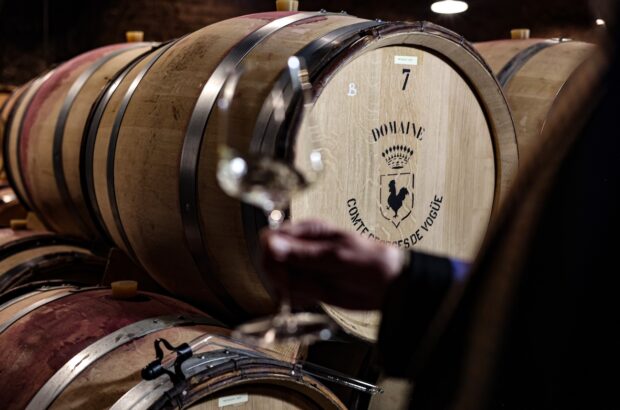Cool nights, fingers of mist caressing the dips and dimples in the land, then long days of lavish sunshine: Bordeaux's weather during the first week of September had an almost eerie perfection to it. And not before time: the celestial taps have been gushing all summer.
2014 Merlot grapes at Angélus
“This year has been WAR AGAINST MILDEW” declaimed Laurent Benoit at Angélus. “The grapes aren’t grapes” joked John Kolasa of Rauzan-Ségla and Canon; “they’re plums. But,” – he looked across the St Emilion plateau towards the church spire, bathed in almost Aegean light – “if this carries on, they’ll dimple a little and we’ll be fine.” Two weeks of warmth should see Merlot ready by late September, with the Cabernets ripe in early October.
Touring Bordeaux when the dark purple grapes are waiting on the vines is a perfect opportunity, you’d think, to gauge yields here, and to work out who is being greedy and who is being restrained. Aren’t lower yields, after all, a fundamental quality key to the best contemporary Bordeaux?
You look at a right-bank vineyard groaning under the weight of bunches and see greed and mischief at work.
A little later, though, you learn that your eyes had fallen on a parcel of young-vine Merlot which is impossible to restrain. The same property’s old-vine Cabernet Franc, hidden on the other side of the hill, carried just a few desultory, loosely constituted bunches of much smaller grapes on each vine – but you didn’t see those.
You then chat to a proprietor who tells you he is aiming for 30 to 35 hl/ha this year (as, for example, at Angélus), while over at Lafite you hear they’re hoping for 45 hl/ha. Ah! So the villains are on the left bank? Not necessarily, because planting densities tend to be higher on the left bank (9,000 to 10,000 plants per ha) compared to the right (6,000 to 7,000 plants per ha). A yield of 45 hl/ha at 10,000 plants/ha means 0.45 litres of wine per vine, whereas 35 hl/ha at 6,000 plants/ha would equate to 0.58 litres per vine. Hmm.
For the record, planting densities are in fact lower than this at Lafite – 7,500 plants/ha. Palmer, by contrast, does indeed have 10,000 plants/ha, and is hoping for 33 hl/ha this year. So Lafite’s vines will be potentially producing 0.6 litres each and Palmer’s 0.33 litres each: a striking contrast, especially since Palmer is planted with 47 per cent of the higher-yielding Merlot compared to Lafite’s 25 per cent. Save your conclusions, though, for a little longer.
Doesn’t green harvesting help? Some properties, indeed, are still hacking away at excess bunches even after véraison (when the grapes change colour), and a September visit will show those discarded bunches lying on the ground. Once you’ve done a green-harvest, though, the remaining grapes tend to swell. You think you’ve cut away half the grapes, but you end up harvesting 65 per cent of the juice. Was that a good idea?
Jean-Michel Comme at Pontet-Canet is deeply opposed to green-harvesting, but for different reasons: he thinks it’s a waste of the plant’s energy. He doesn’t deleaf or hedge, either, but instead makes a Rhône-like ‘bridge’ between the plants to arrest vertical growth, and the yield is controlled by winter pruning: they aim for 35 to 40 hl/ha. But, Comme told me in May, since 2009 they have been using 90 to 95 per cent of production in the grand vin because “the quality of grapes is good enough”. At Ducru-Beaucaillou, by contrast, the grand vin is half total production, and at Léoville-Las Cases it’s less than half. How exactly do we factor that decision into a sage conclusion about yield?
If yield alone was the principal arbiter of quality, then every last case of 2013 Bordeaux would have been snapped up, and 2012 and 2011 would be preferred to 2009 and 2010. (Palmer tries for 35 hl/ha in most years, but only got 20 hl/ha in 2011, 28 hl/ha in 2012 and 25 hl/ha in 2013.) The truth is that, more often than not, the best vintages are also the biggest yielding. Fortunate drinkers are still tucking into the high-yielding and expansive 1982s and 1990s, while the feeble 1984s and 1991s, produced from tiny yields, lie expiring on the cellar floor.
Even in a lovely vintage, just what the ideal yield might be is still a vexed question. Château Margaux once ran an experiment in which a single parcel was divided into three, and the different portions cropped at 20 hl/ha, 40 hl/ha and 60 hl/ha. The middle lot was usually preferred in blind tasting. Anthony Barton of Léoville-Barton has defended taking the maximum yield allowed by the St Julien AOC rules because it creates “wines that people will take pleasure in drinking”. This kind of drinkable classicism has long been espoused by Christian Moueix on the right bank, too — “when, as a couple, you can easily drink a bottle without becoming tired”. Both have contrasted such wines to what they feel is the sometimes strenuous and exhausting concentration achieved by suppressing Bordeaux red-wine yields to below 30 hl/ha (essential, by the way, for any serious red wine in Languedoc or Roussillon).
The perfect yield for red Bordeaux, in other words, perhaps exists, but it eludes definition. It eludes definition because it depends not just on variety, individual vineyard parcel and perhaps even each individual vine – but because it also depends on you, your taste, and the shape and weight of wine you like to feel in your mouth. As so often in our world, an issue which at first looked simple turns out to be exasperatingly complex.
Written by Andrew Jefford







